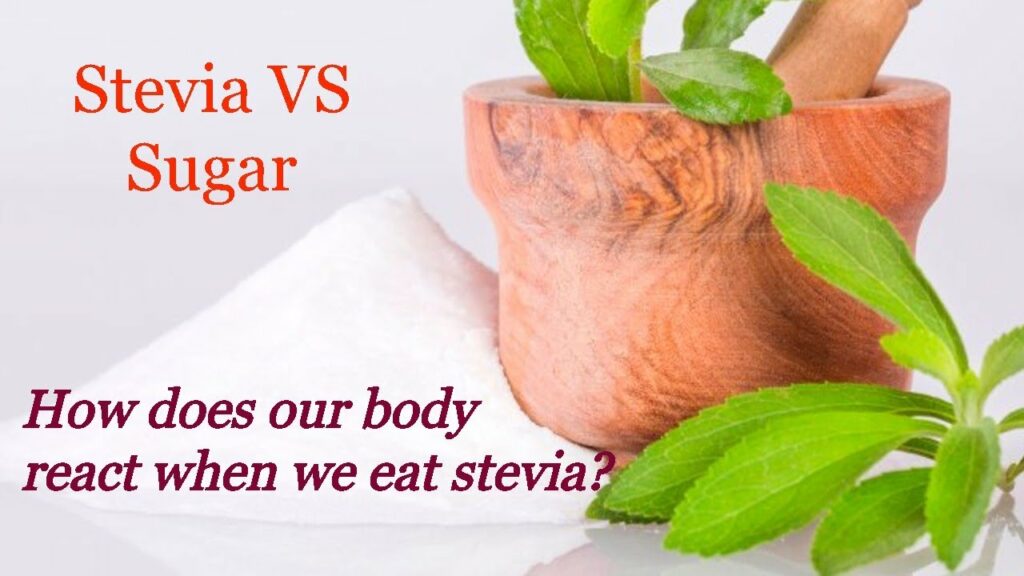Stevia and sugar are two popular sweeteners used to enhance the taste of foods and beverages, but they differ significantly in their nutritional profiles, flavor, and impact on health. While sugar has been a staple sweetener for centuries, stevia has gained popularity as a natural alternative with fewer calories and carbohydrates. In this comprehensive guide, we’ll delve into the differences between stevia and sugar, examining their nutritional facts, calorie content, carbohydrate levels, and other factors to help you make informed choices about your sweetener options.
Understanding Stevia
Stevia is a natural sweetener derived from the leaves of the Stevia rebaudiana plant, native to South America. Stevia contains compounds called steviol glycosides, which are responsible for its intensely sweet taste. These compounds are much sweeter than sugar but contribute minimal calories and carbohydrates to the diet. Stevia is available in various forms, including powdered extracts, liquid extracts, and granulated blends with other sweeteners.
Nutrition Facts
Stevia is virtually calorie-free and contains negligible amounts of carbohydrates. Unlike sugar, which provides four calories per gram, stevia contains zero calories per gram. This makes stevia an attractive option for individuals looking to reduce their calorie intake or manage their blood sugar levels.
Flavor Profile
Stevia has a sweet taste with a slight, sometimes bitter aftertaste, particularly in higher concentrations. The intensity of the sweetness can vary depending on the brand and formulation of the stevia product. Some people may find the taste of stevia to be less satisfying or natural compared to sugar, especially in certain applications.
Culinary Uses
Stevia is commonly used as a sugar substitute in a variety of foods and beverages, including coffee, tea, baked goods, and desserts. It is often recommended for individuals following low-carb or ketogenic diets, as well as those with diabetes or insulin resistance, due to its minimal impact on blood sugar levels.
Understanding Sugar
Sugar also known as sucrose, is a carbohydrate found naturally in fruits, vegetables, and dairy products. It is most commonly extracted from sugar cane or sugar beet plants and refined into granulated sugar for use in cooking and baking. Sugar provides sweetness and acts as a primary source of energy for the body, but excessive consumption has been linked to various health issues, including obesity, type 2 diabetes, and heart disease.
Nutrition Facts
Sugar is calorie-dense, providing four calories per gram. It is also high in carbohydrates, with each gram of sugar contributing approximately four grams of carbohydrates to the diet. While sugar contains no essential nutrients or vitamins, it is a concentrated source of energy that can quickly raise blood sugar levels when consumed.
Flavor Profile
Sugar has a sweet taste with a pleasant mouthfeel, making it a versatile ingredient in a wide range of culinary applications. It enhances the flavor of foods and beverages and provides sweetness and balance to both savory and sweet dishes. Sugar is prized for its ability to caramelize when heated, contributing to the golden brown color and rich flavor of baked goods and desserts.
Culinary Uses
Sugar is a ubiquitous ingredient in the food industry and is used in a wide range of products, including soft drinks, candies, baked goods, sauces, and condiments. It serves as a primary sweetener in desserts such as cakes, cookies, and pastries, as well as in savory dishes to balance flavors and enhance the palatability of sauces and marinades.
Key Differences:
Calorie Content
Stevia is virtually calorie-free, while sugar is calorie-dense, providing four calories per gram.
Carbohydrate Levels
Stevia contains minimal carbohydrates, making it suitable for low-carb and ketogenic diets, while sugar is high in carbohydrates and can quickly raise blood sugar levels.
Impact on Blood Sugar
Stevia has a minimal impact on blood sugar levels and may be suitable for individuals with diabetes or insulin resistance, while sugar can cause rapid spikes and crashes in blood sugar levels.
Flavor Profile
Stevia has a sweet taste with a slight aftertaste, while sugar provides a more balanced sweetness and mouthfeel in culinary applications.
Conclusion
In conclusion, stevia and sugar are two distinct sweeteners with different nutritional profiles, flavor profiles, and culinary uses. Stevia offers a calorie-free and low-carb alternative to sugar, making it suitable for individuals looking to reduce their calorie intake or manage their blood sugar levels. However, some people may find the taste of stevia less satisfying or natural compared to sugar, especially in certain applications. Ultimately, the choice between stevia and sugar depends on individual preferences, dietary needs, and health goals. By understanding the differences between these two sweeteners, you can make informed decisions about which option best suits your lifestyle and culinary preferences.

